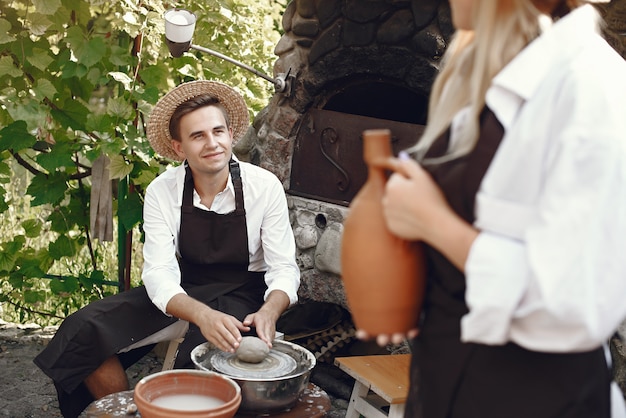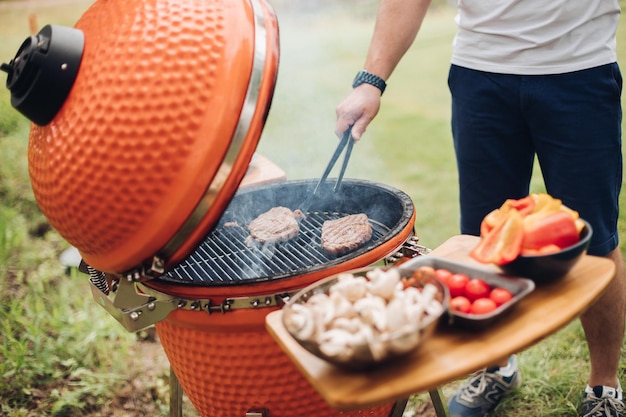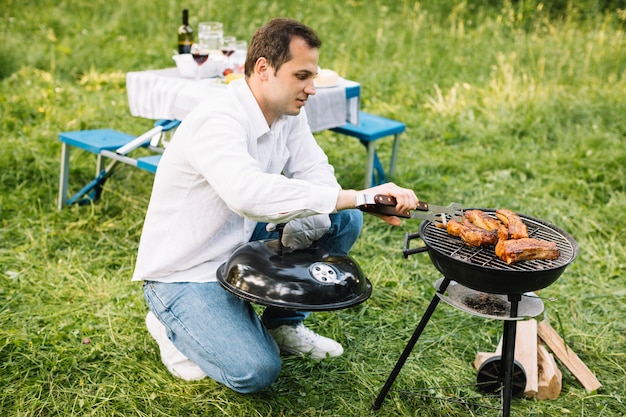There's nothing quite like the aroma of wood smoke mingling with the scent of sizzling meat, especially when you're tackling a big, juicy round roast. It's a symphony of flavors that takes you back to simpler times, a time when cooking was a communal experience, fueled by fire and shared with loved ones. But let's be honest, mastering the art of the outdoor roast isn't always a picnic. I've had my fair share of dry, tough roasts and even a few burnt offerings. But after years of experimenting and refining my technique, I've cracked the code. And I'm here to share my secrets with you, so you can turn from backyard newbie to BBQ boss in no time.
Part 1: Choosing the Right Roast – The Foundation of Flavor

The Meat Makes the Meal
The first step to a delicious roast is choosing the right cut of meat. Now, when it comes to round roasts, you have options! My personal favorites are beef chuck roast and pork shoulder. These cuts are incredibly flavorful, packed with rich marbling, and hold up well to the long, slow cooking method that's key to tender, succulent results. But if you're feeling adventurous, you can always explore other options like lamb shoulder or even venison roast. Just remember, the key is to choose a cut with enough marbling to stay juicy even after hours of cooking.
Size Matters – Feeding Your Crowd
You also need to think about the size of your roast. If you're cooking for a big crowd, you'll need a larger roast, and if it's just for a few people, you can go with a smaller one. A good rule of thumb is about 1 pound of meat per person, but you can always adjust that based on how hungry your guests are. I've learned that it's always better to err on the side of too much than too little – leftover roast is a delicious treat the next day!
Part 2: Preparing the Roast for Success – The Power of Seasoning

It's All About the Seasoning – Layering Flavor
Before you even think about firing up the grill, you need to get your seasoning game on point. This is where your roast truly transforms from a simple piece of meat to a culinary masterpiece. My go-to spice blend for a round roast includes:
- Salt – The foundation of flavor, essential for bringing out the natural sweetness of the meat.
- Black Pepper – A classic addition for a touch of heat and depth.
- Paprika – Adds a warm, smoky note, perfect for complementing the outdoor cooking method.
- Garlic powder – Creates an irresistible aroma and brings a savory richness to the roast.
- Onion powder – Enhances the flavor profile with a hint of sweetness and a savory edge.
But don't be afraid to experiment! You can add other spices like cumin, chili powder, or even a pinch of brown sugar for a touch of sweetness. The key is to use a generous amount of seasoning, which will create a beautiful crust on the outside of the roast while adding layers of flavor to the meat itself.
The Art of Rubbing – Getting the Seasoning in Deep
Once you have your seasoning mix ready, it's time to rub it into the roast. I like to use my hands, which allows me to feel the seasoning getting worked into the meat. But you can also use a brush, making sure to cover every inch of the roast, including those crevices. Once it's completely coated, let the roast sit in the fridge for a few hours, or even overnight. This gives the spices a chance to penetrate the meat and helps to lock in moisture, leading to a juicier, more flavorful end product.
Part 3: Setting Up Your Outdoor Kitchen – Choosing Your Cooking Method

The Choice is Yours – From Grill to Smoker to Campfire
Now comes the fun part: choosing your cooking method. You can cook your roast on a grill, in a smoker, or even in a dutch oven over a campfire. Each method brings its own unique character to the roast, so experiment and find what works best for you. I personally prefer the smoky flavor that comes from a smoker, but any method will work as long as you follow the basic principles of low and slow cooking.
Getting the Grill Ready – Indirect Heat for Even Cooking
If you're using a grill, make sure it's clean and ready to go. You'll want to set up indirect heat, meaning you'll place the roast on one side of the grill and leave the other side empty. This creates even heat and prevents the roast from getting burnt, ensuring a more consistent cooking experience.
Smoker Setup – Wood Chips and Smoky Flavor
For a smoker, add wood chips to the smoker box. I recommend using fruitwood, such as apple or cherry, for a mild and sweet smoke. You can also use hardwoods like hickory or oak for a stronger, more robust flavor. Just remember to soak the wood chips in water for at least 30 minutes before adding them to the smoker. This helps them to produce a consistent, slow-burning smoke that imparts that signature smoky flavor to your roast.
Dutch Oven Delights – Rustic campfire cooking
If you're feeling adventurous and want a truly rustic experience, you can use a Dutch oven over a campfire. Place the roast in the oven, add some wood chips to the bottom, and distribute coals evenly around the bottom of the oven. This method will give your roast a unique smoky flavor and creates a cozy atmosphere perfect for outdoor gatherings. Remember to keep an eye on the coals to ensure even cooking.
Part 4: The Art of Slow Cooking – Patience is Key
Low and Slow is the Way to Go – Breaking Down the Meat for Tenderness
The key to a delicious, tender roast is to cook it low and slow. This allows the meat to break down and become incredibly tender, releasing its natural juices and developing deep, rich flavors. Aim for a temperature between 225°F and 250°F. You can check the temperature with a meat thermometer, making sure to adjust the heat source as needed to maintain the desired temperature range.
Time is Your Friend – cooking times and Monitoring the Roast
Cooking times will vary depending on the size of the roast and the type of meat. A good rule of thumb is to allow about 1.5 hours of cooking time per pound of meat. But keep an eye on the temperature of the roast using a meat thermometer. You don't want to overcook it, so be patient and let the roast cook until it reaches the desired internal temperature. This is where a good thermometer is your best friend! It takes the guesswork out of cooking and helps you achieve consistently perfect results.
Don't Forget the Basting – Keeping the Roast Juicy and Flavorful
To keep the roast juicy and flavorful, you'll want to baste it regularly. You can use a mixture of beef broth or water, and even add some wine or apple cider for extra flavor. Just make sure to baste the roast every hour or so. This helps to keep the roast moist and prevent it from drying out during the long cooking process. The basting liquid also helps to create a beautiful, flavorful crust on the outside of the roast.
Part 5: How to Tell When Your Roast is Ready – Mastering the Signs of Doneness
Using a Meat Thermometer – The Most Accurate Method
The best way to tell if your roast is done is to use a meat thermometer. Here are the safe internal temperatures for various roasts:
- Beef: 145°F (medium rare) – For a juicy, tender roast with a slightly pink center.
- Pork: 145°F – Ensures that the pork is cooked through and safe to eat.
- Lamb: 145°F – For a flavorful lamb roast with a slightly pink center.
- Venison: 145°F – Similar to beef, venison can be cooked to medium rare for a tender, juicy result.
The “Touch Test” – A Quick and Easy Method
If you don't have a meat thermometer, you can use the touch test. Gently poke the roast with a fork. If the meat feels firm and springy, it's done. If it feels soft and jiggly, it needs more cooking time. This method is a good starting point, but it's not as accurate as using a thermometer.
The Visual Cue – Observing the Juices
You can also tell if the roast is done by looking at the juices. If the juices run clear, the roast is cooked through. If they run pink, it needs more time. This is a good visual indicator, but it's best to use it in conjunction with other methods like the touch test or a meat thermometer for greater accuracy.
Part 6: Resting the Roast to Perfection – Letting the Juices Redistribute
Let It Rest – The Key to Tenderness
Once the roast is cooked through, don’t slice into it right away. You need to let it rest for at least 15 minutes before carving. This allows the juices to redistribute throughout the meat, making it even more tender and flavorful. Think of it as a mini-spa treatment for your roast! The resting time allows the muscle fibers to relax, resulting in a juicier, more tender roast.
Cover It Up – Keeping the Roast Warm and Moist
While the roast is resting, cover it loosely with aluminum foil. This helps to keep it warm and prevents it from drying out. The foil traps the steam generated by the roast, creating a warm, humid environment that keeps the meat moist and tender.
Part 7: Carving Your Masterpiece – The Finishing Touches
Sharpen Your Tools – A Must for Clean Cuts
Before you start carving, make sure you have a sharp carving knife. You'll also need a carving fork to help hold the roast in place. A cutting board is also essential for a clean and professional presentation. Sharpen your knives before carving to ensure clean, even cuts. A dull knife will tear the meat and ruin the presentation.
The Art of the Slice – Carving for Tenderness
Start by carving the roast in thin slices. You can carve it against the grain or with the grain, depending on your preference. I prefer to carve against the grain, as it helps to make the meat more tender. Carving against the grain means cutting across the direction of the muscle fibers. This makes the meat easier to chew and allows the flavors to release more easily.
Don’t Forget the Drippings – The Secret Ingredient to Flavor
As you're carving, collect the juices in a small bowl. You can use these to make a delicious gravy for your roast. The drippings are packed with flavor, so don't discard them! Use them to make a rich, flavorful gravy that will take your roast to the next level.
Part 8: side dishes and Serving Ideas – Completing the Meal
Complement the Flavor – Simple Sides that Shine
Now that your roast is cooked to perfection, it's time to think about side dishes. I like to keep it simple with classic sides like mashed potatoes, roasted vegetables, and a green salad. These sides are a perfect complement to the rich flavors of the roast and add a touch of freshness to the meal.
Serving with Panache – Presenting Your Culinary Creation
When serving your roast, make sure to arrange it attractively on a platter. You can also add some garnishes, like fresh herbs or a few slices of lemon. And don’t forget to serve those delicious drippings on the side! A beautiful presentation will make your roast even more impressive. Think about using different colors and textures to create a visually appealing and flavorful spread.
Part 9: FAQs – Answering Your Burning Questions
Q1: What happens if my roast is too dry?
If your roast is too dry, don’t worry! You can add some moisture back into it by making a gravy. Simply whisk together the drippings from the roast, some flour, and some water or broth. Bring it to a boil, then reduce the heat and simmer until the gravy thickens. This will add moisture and flavor to your roast, making it more enjoyable.
Q2: Can I cook a roast in the oven instead of outdoors?
Absolutely! You can cook a round roast in the oven using the same low and slow method. Just preheat your oven to 225°F and cook the roast until it reaches the desired internal temperature. This is a good option if you don't have access to a grill or smoker, or if you prefer a more controlled cooking environment.
Q3: How can I prevent the roast from sticking to the grill?
To prevent the roast from sticking, make sure to lightly oil the grill grates before placing the roast on them. You can also use a non-stick grilling mat. These are great options for preventing the roast from sticking and making cleanup a breeze.
Q4: How do I know when my wood chips are done?
The wood chips are done when they start to smolder and produce a light wisp of smoke. This indicates that the chips are burning properly and producing the smoke that will infuse your roast with that unique smoky flavor.
Q5: Can I freeze a cooked roast?
Yes, you can freeze a cooked roast for up to 3 months. Just wrap it tightly in plastic wrap and then aluminum foil. When you’re ready to eat it, thaw it in the refrigerator overnight, then reheat it in a low oven until it’s warmed through. Freezing is a great way to preserve your roast for later, allowing you to enjoy the delicious flavors even weeks after you cooked it.
Cooking a round roast outdoors may seem daunting at first, but with a little patience and practice, you can become a true BBQ boss! So grab your favorite seasonings, fire up your grill, and get ready to impress your friends and family with a mouthwatering round roast that’s cooked to perfection. Happy grilling!
Everyone is watching

How to Cook Frozen Lobster Tails Perfectly: A Step-by-Step Guide
RecipesLobster. Just the word conjures up images of lavish meals, special occasions, and a taste of luxury. But let's...

Pigs in a Blanket Cooking Time: How Long to Bake for Perfect Results
RecipesAh, pigs in a blanket. Just the name conjures up images of those delightful little parcels of crispy pastry en...

Pork Fillet Cooking Time: How Long to Cook It Perfectly
RecipesPork fillet, or tenderloin as it's sometimes called, is a real favourite in our house. It's so versatile, and...

The Ultimate Guide to Cooking Sweet Potatoes: From Roasting to Mashing
RecipesSweet potatoes. Just the name conjures up images of warm, comforting dishes, bursts of vibrant color, and a to...

The Ultimate Guide to Tender, Juicy Pulled Pork
RecipesRight, let's talk pulled pork. It's one of those dishes that just screams "comfort food," doesn't it? I mean...
